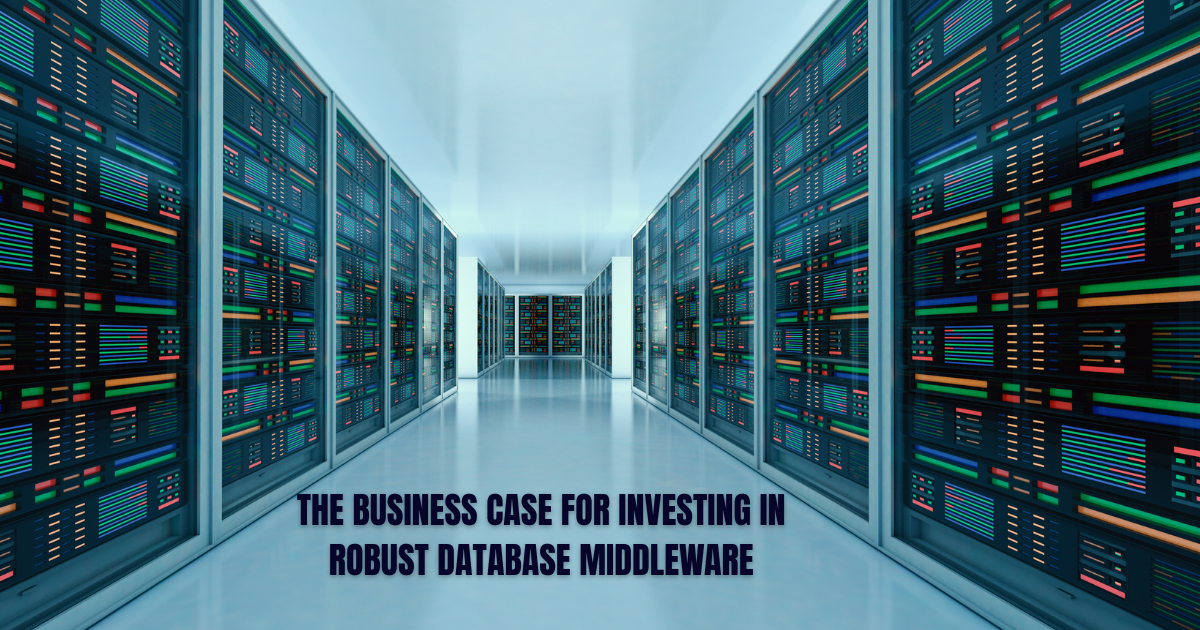The business case for investing in robust database middleware
Data powers every modern business, and managing it efficiently is critical for success. Robust database middleware simplifies complex data operations, enabling seamless database integration while boosting performance and security. By facilitating Business Integration with Middleware, it ensures systems work together effectively, driving operational efficiency and competitive advantage.
Table of Contents
Database middleware
Database middleware is software that sits between applications and databases, facilitating communication and data management. It acts as a bridge, allowing different applications to interact with various databases, regardless of their underlying technologies or locations.
This middleware layer simplifies complex database interactions, enabling developers to focus on building applications rather than managing connectivity issues. For example, it allows a Windows-based application to communicate seamlessly with a Linux-based database.
Types of database middleware
Several types of middleware exist, but database middleware specifically focuses on database access and management. Common examples include:
- Database access middleware (e.g., ODBC, JDBC): Provides standard interfaces for applications to access databases across different platforms.
- Transactional middleware: Ensures data integrity during transactions across multiple databases, vital for industries such as finance.
- Message-oriented middleware: Facilitates real-time data transfer between applications in distributed systems.
- Object request brokers: Enable objects in different applications to communicate, supporting complex systems.
These types ensure that databases and applications work together efficiently, meeting diverse business needs.
Benefits of robust database middleware
- Simplified database integration
Database integration is a cornerstone of modern business operations. Robust database middleware simplifies this process by providing a unified interface for accessing multiple databases, thereby streamlining the process. It eliminates data silos, ensuring that information flows consistently across the organization. This capability is crucial for businesses managing diverse systems, as it enables seamless data sharing and improves decision-making.
2. Standardized interfaces
Middleware solutions provide standardized methods for connecting applications to databases, thereby reducing complexity and minimizing errors. This standardization provides enterprise middleware benefits, such as easier maintenance and consistent data access across diverse IT environments. For enterprises managing multiple databases, this approach simplifies system management and ensures reliability.
3. Improved development efficiency
Middleware accelerates development by allowing developers to focus on application logic rather than database connectivity. Developers use familiar middleware APIs to interact with any supported database, reducing the need to learn complex connection protocols. This speeds up development cycles, enabling businesses to launch new products and services more quickly, thereby giving them a competitive edge.
4. Enhanced security
Security is a top priority, and robust database middleware strengthens it by controlling database access. It acts as a gatekeeper, ensuring only authorized applications and users can interact with the database. This reduces the risk of data breaches and unauthorized changes. Middleware can also implement encryption and other security measures to protect data during transfer, safeguarding sensitive information.
5. Modularization and flexibility
Middleware enables modularization, allowing businesses to update applications or databases independently without disrupting the system as long as the middleware interface remains consistent. This flexibility is essential for adapting to changing market conditions or technological advancements, reducing the need for costly system overhauls. Middleware Integration Solutions make it easier to integrate new technologies, ensuring long-term adaptability and flexibility.
How middleware improves performance
Database middleware performance is a critical advantage for businesses that handle large volumes of data or require real-time processing. Middleware optimizes data access and transfer, ensuring applications remain responsive.
For example, it utilizes connection pooling to maintain a cache of open database connections, thereby reducing the overhead associated with creating new connections for each request. This is particularly beneficial for high-transaction applications, such as e-commerce platforms, during peak sales periods.
Middleware also utilizes caching mechanisms to store frequently accessed data, thereby minimizing database queries and enhancing response times. These optimizations enable businesses to process data efficiently, thereby improving user satisfaction and operational performance.
Serverless middleware for scalability
Modern database middleware solutions include robust serverless middleware solutions, such as Amazon Aurora Serverless. These solutions automatically scale to meet workload demands, eliminating the need for manual intervention. For instance, during sudden traffic spikes, serverless middleware adjusts resources to maintain performance, ensuring reliability. This scalability is cost-effective, as businesses pay only for the resources they use, making it ideal for fluctuating workloads.
Return on investment (ROI)
Cost savings
Investing in robust database middleware delivers significant cost savings, a key component of middleware ROI. By automating database management tasks, middleware reduces the need for extensive IT resources, lowering operational costs.
Serverless options further optimize expenses by charging only for actual resource usage, thereby avoiding costs associated with idle infrastructure. These savings allow businesses to allocate resources to strategic initiatives, enhancing overall efficiency.
Increased productivity
Middleware solutions streamline development and reduce downtime caused by database issues, boosting IT team productivity. This efficiency enables faster development and deployment of applications, leading to quicker time-to-market for new products and services.
The enterprise middleware benefits of simplified management and reliable systems allow teams to focus on innovation, driving revenue growth and competitive advantage.
Potential drawbacks of robust database middleware
While database middleware offers significant benefits, it’s important to consider potential drawbacks to ensure informed decision-making:
- Increased complexity in setup and maintenance: Implementing middleware can introduce additional complexity, requiring specialized expertise to configure and maintain. Businesses may need to invest in training or hire skilled personnel, which could offset initial cost savings.
- Performance overhead: Middleware adds an extra layer between applications and databases, which can introduce latency in certain scenarios, particularly if not optimized properly. This could impact performance for applications requiring ultra-low response times.
- Vendor lock-in: Some middleware solutions, especially proprietary or cloud-based options like serverless middleware, may tie businesses to specific vendors. Switching providers could involve significant costs and effort due to compatibility issues or data migration challenges.
- Security risks if misconfigured: While middleware enhances security when properly implemented, misconfigurations can create vulnerabilities. For example, improper access controls or unpatched middleware could expose databases to attacks.
- Cost considerations for scalability: Although serverless middleware is cost-effective for fluctuating workloads, costs can escalate unexpectedly during sustained high-demand periods. Businesses must carefully monitor usage to avoid budget overruns.
Addressing these drawbacks requires careful planning, regular maintenance, and a clear understanding of the organization’s needs to maximize the benefits of middleware while minimizing risks.
Database middleware adoption trends
Trends in database middleware adoption highlight its growing importance in modern IT strategies. As businesses increasingly adopt cloud-based solutions and microservices architectures, the need for effective middleware to manage database interactions becomes more pressing.
Middleware ensures that these modern architectures operate efficiently, supporting complex, distributed systems. For those seeking real-world examples, searching for a Middleware case study can provide insights into successful implementations. However, detailed examples are beyond this article’s scope.
The business case for investing in robust database middleware is clear. It simplifies database integration, enhances database middleware performance, strengthens security, and delivers significant middleware ROI through cost savings and productivity gains. By adopting Middleware Integration Solutions and robust serverless middleware, businesses can effectively manage complex data environments. Business Integration with Middleware ensures that diverse systems work together, positioning organizations for success in the digital age.
FAQS
Q1. Why should businesses invest in middleware?
Middleware streamlines communication between disparate systems, enhancing efficiency, scalability, and integration of applications and data.
Q2. Does middleware reduce operational costs?
Yes, middleware can reduce costs by automating processes, minimizing manual intervention, and optimizing resource use through efficient system integration.
Q3. Is middleware useful for small businesses?
Yes, middleware helps small businesses integrate affordable tools, improve workflows, and scale operations without needing complex, costly systems.
Q4. How does middleware impact ROI?
Middleware boosts ROI by improving operational efficiency, reducing integration costs, and enabling faster deployment of new services or applications.
Author








